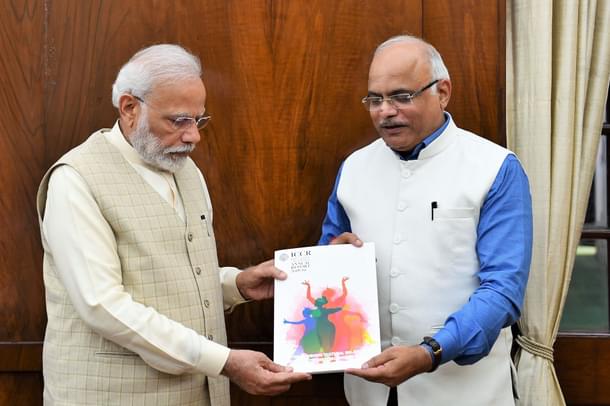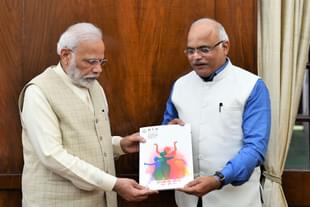Ideas
Building Nalandas In 21st Century: ICCR Conference Shares Report With PM Modi Suggesting Ways To Attract Foreign Students Via Indic Knowledge Systems
Swarajya Staff
Feb 13, 2020, 11:00 AM | Updated 10:58 AM IST
Save & read from anywhere!
Bookmark stories for easy access on any device or the Swarajya app.


The Indian Council for Cultural Relations (ICCR) organised a national conference, ‘Destination India — Making India the Preferred Hub of Education’, on 28 and 29 January at Symbiosis International University, Pune.
The conference brought together leading educationalists, stakeholders from the industry, and other policy experts who deliberated on the objective of making India one of the leading hubs of education for foreign students.
The ICCR conference held under the leadership of its president Dr Vinay Sahasrabuddhe was intended to aid the government of India which has launched ‘Study in India’ (SII) initiative where it plans to increase the number of foreign students to more than 2 lakh.
Currently, around 40,000 students are enrolled in Indian universities while the figure for Indian students studying abroad is more than 7 lakh. The gap is huge and SII initiative hopes to bridge it to some extent by 2023.
Former presidents of Afghanistan and Nepal, Myanmar’s State Counsellor Aung San Suu Kyi have studied in India apart from some ministers, bureaucrats and businessmen who are in positions of power in our neighbouring countries. The government thus understands that education can become a big source of soft power for the country.
While various stakeholders discussed and debated many aspects of attracting foreign students to India (read detailed report here), one of the key focus areas that stood out was how to make the country an attractive centre for studies of traditional Indic knowledge systems (TIKS).
India in ancient times was Vishwa Guru thanks to universities like Nalanda, Takshashila, Vikramshila, which attracted students from all over the world. Many in the current government have talked about their wishes to go back to that India of yore.
Before the conference, Dr Sahasrabuddhe told Swarajya in an interview that time has come to reclaim the lost glory.
“India, historically, was a global education hub. We had some of the greatest universities of the world, starting with Nalanda, Takshashila and Vikramashila that served as the melting pot of scholars from across the world. Yes, those days of civilisational greatness are behind us, but I believe that the Indian education system is in a phase where it is reconstructing itself, and this is the ideal start for India to become a global education hub.”
In a column for think tank Observer Research Foundation, Banuchandar Nagarajan who was an adviser to Dr Sahasrabuddhe for the ICCR conference, explained how India is uniquely placed to offer foreign students a range of courses which no other country can match.
“Indian music, cuisine, movies, spirituality, craft and tourism are already sources of attraction for the rest of the world. Just like yoga, the value proposition and authenticity of our offering should stand out,” he wrote.
Nagarajan chaired a session at the conference on traditional Indic knowledge systems and culture with renowned panelists Padma Shri Chamu Krishna Shastry, Dr Ishwar Basavaraddi from Ministry of AYUSH and Muslim kathak dancer and guru Rani Khanam.
“It takes 17-20 years to master the Indian classical dance forms. We have to understand what foreign students actually want to do. Some look at Bollywood and think they should learn classical art form,” Rani Khanam told the audience from her own experience of teaching foreign students who have received ICCR scholarship.
The solution, according to Khanam, is to prepare specialised, specific courses and have a stricter filtering process so that only those with some background and genuine interest apply and come here to learn.
Padma Shri Chamu Krishna Shastry, founder of Samskrita Bharati movement, aimed at reviving Sanskrit and making it popular across the world, said that many foreign students have taken to Indian knowledge systems but they read translated versions and aren’t satisfied with it and it was a big problem. “They want to read them in Sanskrit. The demand to learn the language is growing fast,” he said.
“Sanskrit is the language of Yoga. It is the language of Ayurveda. It is the language of Indian philosophy. Without Sanskrit, understanding of these topics will remain incomplete. So these topics should be clubbed with Sanskrit language learning,” Professor Shastry suggested.
Dr Ishwar Basavaraddi, director of Morarji Desai National Institute of Yoga, Ministry of AYUSH, said that most of the foreign students come to study yoga for five purposes — fitness, wellness, education, therapy, spiritual quest, and keeping this in mind, the Ministry of AYUSH has come up with structured courses and skill sets that foreign students can learn.
Nagarajan concluded the session by quoting from Sri Aurobindo’s Uttarpara speech. “She does not rise as other countries do, for self or when she is strong, to trample on the weak. She is rising to shed the eternal light entrusted to her over the world...”.
At the end of the conference, a detailed report was prepared collating all the suggestions and recommendations reached at by various stakeholders — foreign students, leading educationists representing top universities in the country, bureaucrats in charge of various departments.
ICCR president Dr Vinay Sahasrabuddhe called on Prime Minister Narendra Modi on 10 February (Monday) and presented him a copy of the report.





